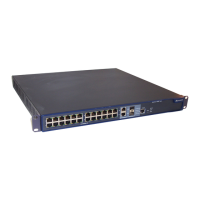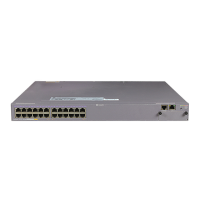Command Manual – Routing Protocol
Quidway S8500 Series Routing Switches Chapter 3 OSPF Configuration Commands
Huawei Technologies Proprietary
3-54
View
OSPF area view
Parameter
route-id: Router ID of virtual link peer.
dead seconds: Specifies the interval of dead timer. It ranges from 1 to 8192 seconds.
This value must equal the dead seconds of the router virtually linked to it and must be
at least four times of hello seconds. The default value is 40 seconds.
dead minimal multi-hello packets: Specifies the virtual link to run Fast Hello function.
The default dead is 1 second. The packets argument refers to the number of Hello
packets sent within 1 second, in the range of 3 to 10.
retransmit seconds: Specifies the interval for re-transmitting the LSA packets on an
interface. It ranges from 1 to 8192 seconds. The default value is 5 seconds.
trans-delay seconds: Specifies the interval for delaying transmitting LSA packets on an
interface. It ranges from 1 to 8192 seconds. By default, the value is 1 second.
hello seconds: Specifies the interval for sending Hello packets on an interface. It
ranges from 1 to 8,192 (in seconds). This value must equal the hello seconds value of
the router virtually linked to the interface. By default, the value is 10 seconds.
simple password: Specifies the simple text authentication password, not exceeding 8
characters, of the interface. This value must equal the authentication key of the virtually
linked peer.
keyid: Specifies the MD5 authentication key ID. Its value ranges from 1 to 255. It must
be equal to the authentication key ID of the virtually linked peer.
key: Specifies the MD5 authentication key. If it is input in a plain text form, MD5 key is a
character string in the range 1 to 16 characters. It will be displayed in a cipher text form
in a length of 24 characters when the display current-configuration command is
executed. Inputting the MD5 key in a cipher text form with 24 characters is also
supported.
Description
Use the vlink-peer command to create and configure a virtual link.
Use the undo vlink-peer command to cancel an existing virtual link.
According to RFC2328, the OSPF area should be connected with the backbone
network. You can use the vlink-peer command to keep the connectivity. Virtual link can
be regarded as a common OSPF-enabled interface so that you can easily understand
why to configure the parameters such as Hello, retransmit, and trans-delay on it.
One thing should be mentioned. When configuring virtual link authentication, the
authentication-mode command is used to set the authentication mode as MD5 cipher
text or simple text on the backbone network.

